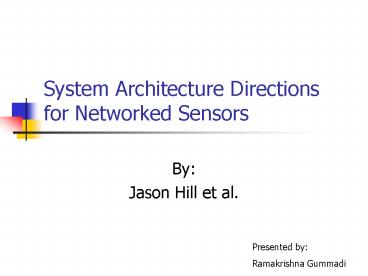System Architecture Directions for Networked Sensors - PowerPoint PPT Presentation
1 / 17
Title:
System Architecture Directions for Networked Sensors
Description:
... low power consumption, low cost= no h/w abstraction. High task concurrency ... Multiple stacked components increase abstraction (analogous to fs over generic ... – PowerPoint PPT presentation
Number of Views:34
Avg rating:3.0/5.0
Title: System Architecture Directions for Networked Sensors
1
System Architecture Directions for Networked
Sensors
- By
- Jason Hill et al.
Presented by Ramakrishna Gummadi
2
Problem Description
- Designing and quantifying a tiny operating
platform for sensor networks - Providing base for designing future networked s/w
for sensor networks
3
High Level Accomplishments
- Better balanced computation communication
- Proc. consumes 0.8microJ, does 100 instructions
while xmitting 1bit_at_1.9microJ - Low latency!
- Extremely efficient and specialized execution
model - Nice s/w architecture
- Builds upon past lessons from distributed
systems, hpc, s/w PL design, etc.
4
Requirements for n/w sensors
- Small physical size, low power consumption, low
costgtno h/w abstraction - High task concurrency
- Managing information flow
- Interleaved computation communication
- Modest but essential data processing at every
step, involving software several layers - Streaming architecture
- Little/no buffering
- Multihop data routing
- Real-time requirements (bounded jitter, etc.),
extended event processing (aggregated events) - Limited scope for physical //ism, hierarchical
h/w design - System-level p2p vs. mu-c centric p-p star design
- App specific, non-federated, but
- Reusable, easily synthesizable s/w platform
- Generic dev. environment, h/w customization
- Robustness
- numerous, autonomous, long-lived units
- prohibitive communication overhead for
multi-layer redundancy (but app-level ok) - modularity helps
5
H/W description
- Atmel MCU
- 8-bit data, 16-bit address, Harvard architecture
- 32 8-bit general registers, 4Mhz, 3.0V
- 8KB flash pgm., 512B SRAM data
- Timers, counters, interrupts, ADC/DAC, UART, etc.
- 3 sleep modes idle, power down, power save
- RF
- 19.2Kbps on-off keyed RF monolithics 916.50Mhz
tranceiver - Support for signal strength and sensitivity
measurement, power mgmt. - Zero buffer, bit-serving, unlatched transmitted
value, jitter propagation (IOW, NO abstractions) - Temp. sensor
- digital, internal A/D, standard chip-chip I2C
protocol (generic serial synchronous) - micro-C s/w synthesizes I2C master on general
I/O pins, no h/w arbiter (s/w supervised bus
negotiationsgtNO abstractions) - Coprocessor for IPLing MCU over SPI (gernic
1Mbit sync. serial) - 256KB EEPROM, 2KB Flash pgm., 128B SRAM
- Possibility for battery strength/health
monitoring, radio xmission. strength actuator,
etc.
6
(No Transcript)
7
Power Characteristics
- Active
- LED, RF MCU 60mW (19.5mA_at_3V)
- Inactivegt10microA
- Orders of magnitude savings possible
- Lesson Work rapidly, sleep mostly
- Lower the duty cycle
8
Power data (from paper)
9
TinyOS
- Goals similar to highly concurrent scalable
Internet systems design - Two prev. approaches
- physical //isms, VMs
- Alt extremely efficient multithreading engine
- Two-level scheduling structure
- avoids live-locks, minimal protection for DOS,
etc. - Programmable FSM design principles (involves PL,
s/w checker models, etc.) - Inter-changeable s/w h/w modules
- Traditional stack-based architecture inefficient
because - individual stack frame memory
- high context-switch overhead (40,000 ctxs/s!)
- No blocking/polling
- Minimize activity, no unbounded buffers, expose
more choices to s/w (flexibility trading off
power for CPU speed, etc.), realtime possibility - use c/b, events instead
10
TinyOS Design
- Small scheduler, components arranged as a
data-flow graph - Component
- command handlers (downcalls), event handlers
(upcalls), fixed-size frame, simple threads - Strongly typed, signatures used to compose
applications - Modular/reusable
- Compile-time checking insures safety
- Commands specify what components they expose
(consume), events specify what they return
(produce) pumps and drains model---flexible
natural - H/W abstracted as components Typed objects move
between nodes (components) in graph - Structured subset of C
11
Design (contd.)
- Static memory allocationgtmemory requirements
frozen at compile time, no dynamic mgmt.
overhead, no runtime pointer chasing - Asynchronous execution model
- Commands (non-blocking requests) call into
lower-level components - Single function call cost
- Specify where to find actual parameters in its
stack frame, return immediately along with status - Optionally schedule a thread for execution
- Fixed (even 1!) number of threads in a component
- Event handlers complete work, report work status
12
Event Handlers
- Triggered by h/w events (interrupts, watchdogs,
timers, etc.) at lowest level - Can deposit info into frame, schedule threads,
signal higher level events, call lower-level
commands - Upcalls trigger fountain of processing that
wind upward through events, and downward through
commands - Loop prevention commands cannot signal events
- Command/events execute as atomic units within a
thread (run to completion)
13
Example component (from paper)
14
Threads
- Threads/events execute asynchronously, dont spin
or wait - Can call lower level commands, signal higher
level events, schedule more threads - Single stack assigned to current thread
- Never block or spin wait
- Thread bundles for richer computation models
15
Scheduler
- Currently simple FIFO w/bb
- Power aware
- Hardware triggered
16
(No Transcript)
17
Example Application Notes
- H/W exposed as components
- Unlike traditional device drivers
- Multiple stacked components increase abstraction
(analogous to fs over generic SCSI disk driver
over specific SCSI h/w controller) - Permits easy migration of s/w h/w boundary
- General principle for constructing components
- when possibility of blocking, make new component
- For modularity (sufficient work accumulatedgtnew
component) - App with 3KB pgm. memory, 226B data memory
(including scheduler) - AM model
- registered handlers, typed data
- Fixed message size
- Safe and efficient multiplexing































